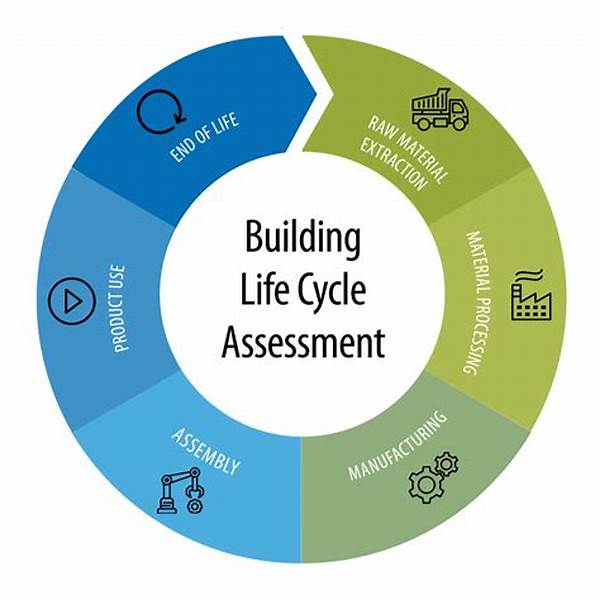Once upon a time, in a city bustling with skyscrapers and buzzing with people, there was an architect named Sam. Sam was not your typical architect; he saw buildings not just as lifeless structures but as dynamic entities with stories to tell—from their inception to their eventual demolition. One day, as Sam was sipping coffee while sketching skyscrapers, he had an epiphany. What if we could measure a building’s story from birth to end, calculate every resource used, and every impact caused? Enter the life-cycle assessment for buildings—a game-changer in the realm of architecture and construction.
Read Now : Wallet-friendly City Living Designs
Why Life-Cycle Assessment for Buildings Matters
Now, you might be wondering, “What’s the big deal with this life-cycle assessment for buildings thing?” Well, hold on to your hats. This isn’t just some fancy architect jargon. It’s like giving buildings a health check-up—from the moment they’re a twinkle in the architect’s eye to their last standing brick. Life-cycle assessment for buildings is all about getting the lowdown on the resources consumed and emissions produced. It’s a sustainability superstar, helping us figure out how to build better with minimal environmental hiccups. Imagine cutting down waste and being an eco-warrior while constructing! That’s what life-cycle assessment for buildings is all about, mate.
In a world turning towards green this and eco-friendly that, using life-cycle assessment for buildings keeps us in check. It nudges us to think about the sneaky little footprints our grand construction projects leave behind. So, folks in construction gear, if you’re looking to be on Santa’s nice list, this right here is your golden ticket. Life-cycle assessment for buildings ensures that we’re not only building masterpieces of steel and glass but also helping Mother Earth breathe easy.
Breaking Down Life-Cycle Assessment for Buildings
1. The Blueprint Phase: This is where life-cycle assessment for buildings kicks off. We gotta sketch it all out, thinking of materials and processes, right from scratch.
2. Material Check: Like a shopping spree, but for steel and bricks! Here, life-cycle assessment for buildings makes us pick the green options.
3. Construction Commotion: It’s where the magic happens. But life-cycle assessment for buildings ensures we keep the waste and emissions in check.
4. Live & Kickin’: Buildings are livin’ it up! Use-life gets scrutinized to minimize energy consumption and maintain that green glow.
5. Adios, Amigos: The endgame—life-cycle assessment for buildings sees how a structure bows out, making recycling and disposal an eco-friendly farewell.
The Real Deal—Life-Cycle Assessment for Buildings
Let’s cut to the chase. Life-cycle assessment for buildings isn’t some mysterious code only architects crack. Nah, it’s as simple as pie! Imagine having this superpower to see the shortcuts to reduce carbon footprints. It’s like being the superhero who saves the day every time a new office block springs up. Through LCA, we look at every nitty-gritty detail—from picking materials to the construction phase, all the way to demolition day. It’s like knowing from Day 1 how to keep things tidy on this good ol’ Earth.
Read Now : Efficient Resource-sharing Communities
Folks running the show—architects, engineers, planners—are all about this life-cycle assessment for buildings. They’re whispering, “Let’s keep this planet going strong for the kiddos!” And why not? Using LCA bridges the gap to a cleaner future. It’s about thinking long-term, buddy. Every decision becomes a step toward reducing that sneaky carbon footprint and making our cities glorious without costing the Earth its well-being. Life-cycle assessment for buildings is not just talk; it’s action with a capital A!
Gettin’ Down with Life-Cycle Assessment for Buildings
So why should you, Mr. or Miss Average Joe, care about life-cycle assessment for buildings? Here’s the short and sweet of it. This thing’s not just for the drafting tables and hard hats; it’s for every apartment dweller and office lover. The smart move is knowing your habitat isn’t tearing up the planet. Life-cycle assessment for buildings is the backstage pass to seeing how every nail and plank fits into the global puzzle of sustainability.
Whether it’s your chill pad in the suburbs or the shiny office downtown, life-cycle assessment for buildings ensures it ain’t an eco-disaster waiting to happen. By weighing out the life span and environmental impact, we, ordinary people, get to live guilt-free knowing our comfy cushions aren’t wreaking havoc on nature. It’s like investing in a better tomorrow without sweating it today. So, life-cycle assessment for buildings is everyone’s all-access pass to sustainable living. Let’s jump on board!
The Nitty-Gritty of Life-Cycle Assessment for Buildings
Life-cycle assessment for buildings isn’t exactly rocket science, but it ain’t child’s play either. It’s the crucial step toward sustainability, revealing the hidden tidbits of a structure’s lifespan. And hey, let’s be real, we all wanna be part of something bigger and cooler. Life-cycle assessment for buildings is precisely that—a deep dive into smarter ways of constructing the stuff we use every day. You see, it’s a chance to reshape how we view our skylines and embrace embracing eco-conscious decisions.
Ponder this, when you see life through a life-cycle assessment for buildings lens, each decision starts to click. The significance multiplies as you realize how small changes make monumental waves. So, life’s looking better with LCA in the picture, crafting a roadmap lined with good vibes and green choices. This isn’t just about concrete and mortar; it’s about a vision—a future where each layout is considerate of its environmental story. Ain’t that something? Who knew thinking about bricks could be so profound?
